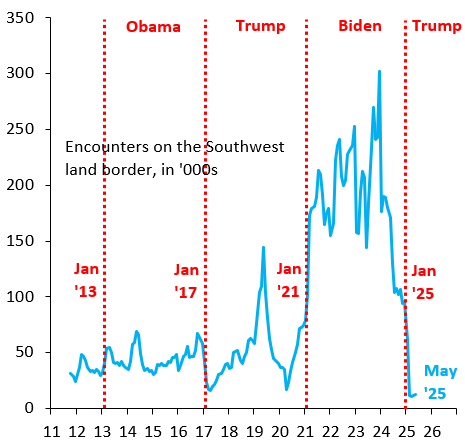How did we end up here?
Part 4: The Biden immigration wave collided with an increasingly divided labor market
The US labor market has a reputation for being flexible and dynamic. The problem is that it’s also highly segmented. As I’ve documented this week, prime-age men began dropping out of the labor force after the global financial crisis, with this phenomenon especially acute among younger men. So even though there’s been lots of job creation, that’s evaded a big chunk of the population, which began to drift towards populism. Then came the Biden immigration wave, which exacerbated resentment in a labor market that was already difficult for some.
The US yesterday published data for “encounters” on the Southwest land border for May 2025. Encounters include apprehensions at the border, including of people who are deemed inadmissible, and expulsions to the country of last transit (usually Mexico) or the home country. These data are a good proxy for unauthorized immigration at the national level, for which data only start in 2019. The chart shows monthly encounters back to 2011. It marks the start of every new administration back to President Obama.
Several things emerge from the chart. First, the immigration wave under President Biden was unprecedented. Some of this reflects pent-up demand, since the COVID pandemic sharply reduced immigration that had been on a rising track in the first Trump administration. Second, immigration has gone to near zero from February 2025, which the second Trump administration has achieved by leaning on Mexico (including by threatening tariffs). No matter which side of the immigration debate you’re on, this shows that the border is enforceable. Third, the immigration wave under President Biden collided with a segmented labor market that - while it was healthy on the surface - was leaving more and more people on the sidelines.
Of course, it’s impossible to say if the Biden immigration wave cost the Democrats the 2024 election. There were other issues at play, most obviously high inflation in the years after the pandemic. My sense is that many people self-censor on this topic because it’s so politically charged, which means dissatisfaction was perhaps a lot higher than polls picked up. In my opinion, this is why the Democrats lost the election and is how we ended up here.

